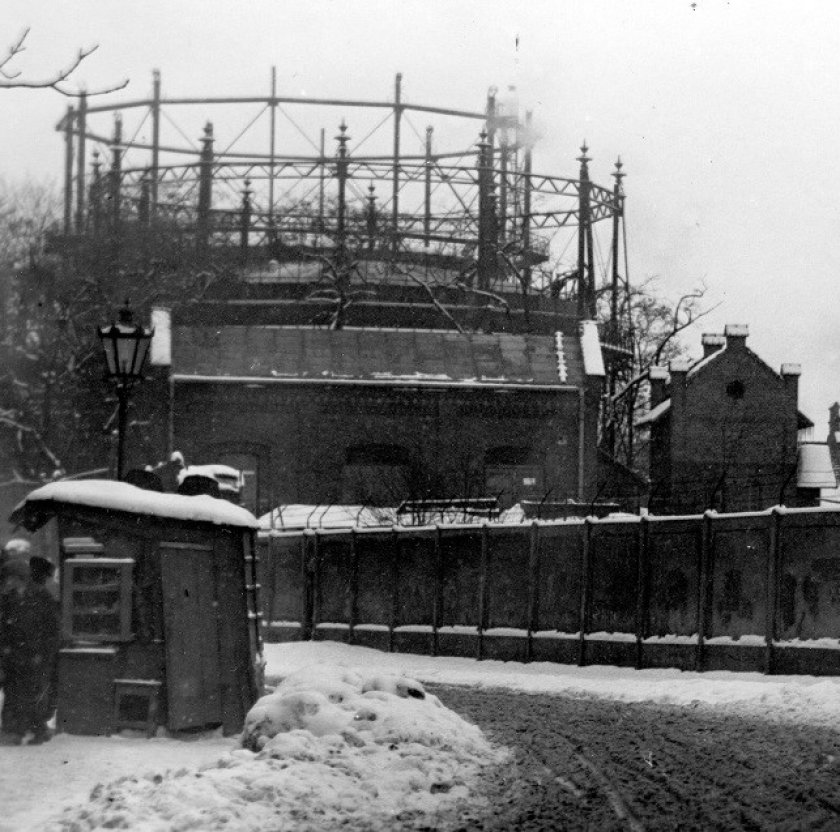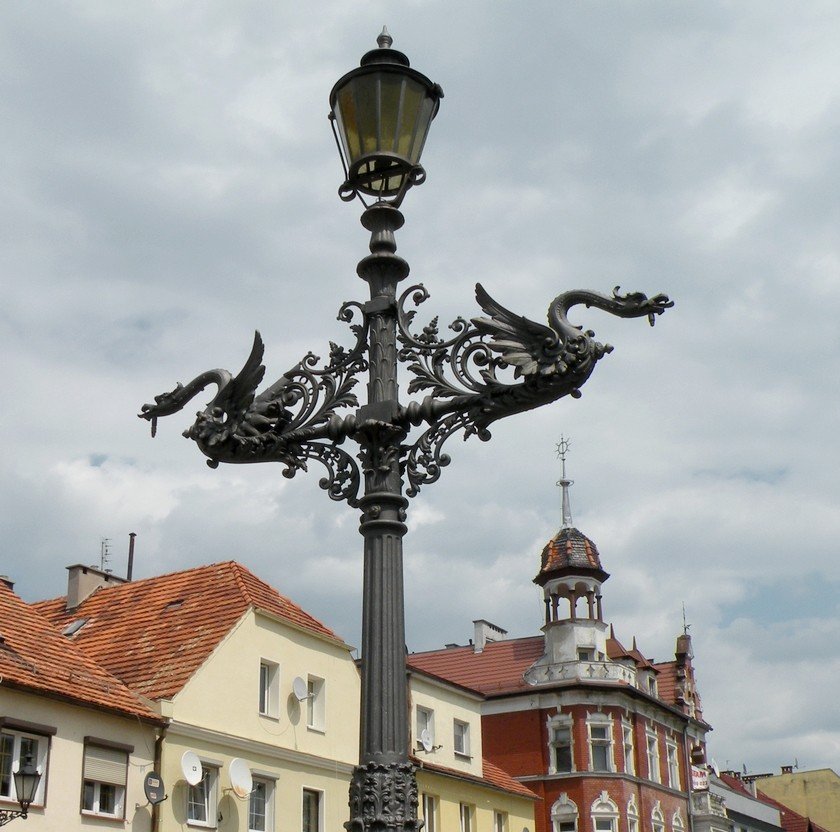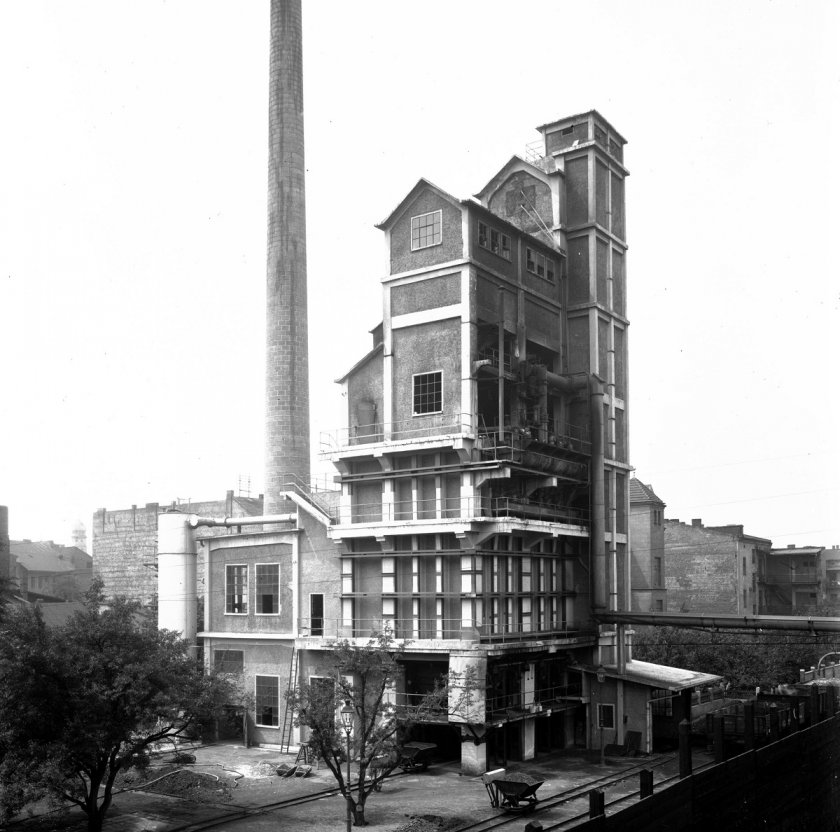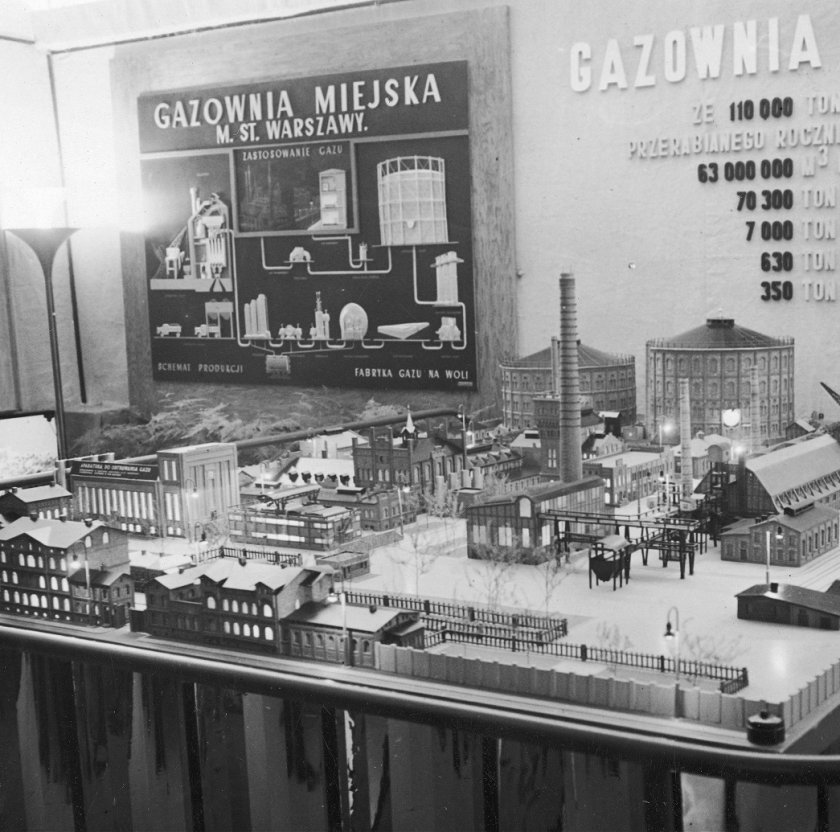History of Lviv Gasworks
 Fot.
Fot.
These developments were reflected in the modernisation of the urban infrastructure, which accelerated in the second half of the 19th and early 20th century. In this context, Lviv was considered as an example to follow by other cities of the former Polish-Lithuanian Commonwealth. Without a shadow of a doubt, the decision to build a modern gasworks on the Poltva River was crucial to the city's progress. The idea of gasification of Lviv was born just after the Springtide of Nations, in the early 1850s. The plans for constructing a gasworks had to be postponed due to the city's finances, which were very poor at the time.
The weakness of the Galician financial and credit sector did not make things any easier either, resulting in difficulties in obtaining credit for the planned project. Therefore, the citizens of Lviv found it necessary to follow the best practices of Western Europe, where such costly investments as gasworks were carried out in cooperation with private investors.
Unfortunately, for the major European players involved in the gasification of the "old continent" at the time, the offer of cooperation with a peripheral - as Lviv was then perceived - city was not attractive. Of the companies present on the market, only the newly formed German Continental Gas Society based in Dessau (Deutschen Continental-Gas-Gesellschaft zu Dessau), commonly known as the Dessau Society, expressed genuine interest in the offer made by the Lviv authorities.
Unfortunately, for the major European players involved in the gasification of the "old continent" at the time, the offer of cooperation with a peripheral - as Lviv was then perceived - city was not attractive. Of the companies present on the market, only the newly formed German Continental Gas Society based in Dessau (Deutschen Continental-Gas-Gesellschaft zu Dessau), commonly known as the Dessau Society, expressed genuine interest in the offer made by the Lviv authorities.
The bilateral agreement between the company from the duchy of Anhalt-Dessau and the municipality of Lviv was signed on 12 February 1856. The agreement was very similar to those which the Society had previously concluded with the authorities of Kraków and Warsaw.
According to the contractual provisions, the Germans undertook to build a gas plant at their own expense, which would then produce gas to be used for lighting public spaces and private homes in Lviv. In return, the municipality undertook to transfer investment land free of charge and to purchase the fuel produced for a period of 25 years. After this time, the municipality had the option to buy out the gasworks. However, if the city did not take advantage of this opportunity, the contract would be automatically extended by another 15 years, i.e. until the end of August 1898. After that date, the gasworks was to become the property of the city at no cost.
According to the contractual provisions, the Germans undertook to build a gas plant at their own expense, which would then produce gas to be used for lighting public spaces and private homes in Lviv. In return, the municipality undertook to transfer investment land free of charge and to purchase the fuel produced for a period of 25 years. After this time, the municipality had the option to buy out the gasworks. However, if the city did not take advantage of this opportunity, the contract would be automatically extended by another 15 years, i.e. until the end of August 1898. After that date, the gasworks was to become the property of the city at no cost.
Built in the area of Źródlana street, the gasworks was commissioned on 21 May 1858. Almost from the very beginning, it generated income that exceeded the initial forecasts of the Dessau Society, which prompted its management to seek to renegotiate the 1856 agreement.
In the summer of 1864, it was proposed to the municipality to completely renounce the rights to the gasworks in exchange for a reduction in the price of the fuel, which was to happen steadily with increasing demand. There were also plans to extend the gas network by a further 11 kilometres. This and subsequent offers to amend the existing contract were tempting from a short-term perspective. The Lviv City Council in 1871 appointed a special committee for gas issues to evaluate the proposals submitted by the owner of the gasworks. The committee proposed to extend the contract until... 1958, which did not meet with the approval of the city councillors.
In the summer of 1864, it was proposed to the municipality to completely renounce the rights to the gasworks in exchange for a reduction in the price of the fuel, which was to happen steadily with increasing demand. There were also plans to extend the gas network by a further 11 kilometres. This and subsequent offers to amend the existing contract were tempting from a short-term perspective. The Lviv City Council in 1871 appointed a special committee for gas issues to evaluate the proposals submitted by the owner of the gasworks. The committee proposed to extend the contract until... 1958, which did not meet with the approval of the city councillors.
In 1882, the Council decided to wait until the end of the contract for the unconditional takeover of the gasworks by the municipality, and, at the same time, the councillors affiliated in the financial section publicly expressed their critical opinion of the previous cooperation with the owner of the gasworks:
For twenty-five years, we have been paying a heavy tribute to the company, so let us endure fifteen more years \... and we will finally reach the point where we will no longer be dependent on the speculative company, where we will rule our own city and own the gasworks, which will provide moderate prices for gas for the municipality and its inhabitants and, what is more, will generate a considerable annual income for the municipality, which in the future will ease taxes collected for municipal purposes [as cited in A. Teodorowicz, "O rozwoju gazowni we Lwowie (1858-1918)", Przegląd Gazowniczy, issue 1, 1921, p. 4].
For twenty-five years, we have been paying a heavy tribute to the company, so let us endure fifteen more years \... and we will finally reach the point where we will no longer be dependent on the speculative company, where we will rule our own city and own the gasworks, which will provide moderate prices for gas for the municipality and its inhabitants and, what is more, will generate a considerable annual income for the municipality, which in the future will ease taxes collected for municipal purposes [as cited in A. Teodorowicz, "O rozwoju gazowni we Lwowie (1858-1918)", Przegląd Gazowniczy, issue 1, 1921, p. 4].
On 1 September 1898, the Lviv gasworks became the property of the municipality. Before this could happen, however, the Dessau Society offered a ten-year lease of the gasworks, promising in return a fixed income for the town calculated at 45,000 crowns per year. At the same time, the municipality was expected to expand the gasworks at its own expense so that it could meet the steadily growing demand for gas supplies. The cost of this investment was estimated at around one million crowns. The proposal caused justifiable consternation among city councillors, who saw it as highly disadvantageous to the city budget.
However, the idea of the costly modernisation of the gasworks was not actually dropped. On the contrary, it became a priority. In view of this, the City Council decided to make appropriate preparations for taking over the gasworks from the Dessau Society. Therefore, in 1895 a committee was appointed from among the councillors to develop a programme for the future development of the gasworks.
However, the idea of the costly modernisation of the gasworks was not actually dropped. On the contrary, it became a priority. In view of this, the City Council decided to make appropriate preparations for taking over the gasworks from the Dessau Society. Therefore, in 1895 a committee was appointed from among the councillors to develop a programme for the future development of the gasworks.
In 1897, the members of the committee approved the plan to refurbish the apparatus responsible for the production of coal gas, as well as the need to renovate the heavily exploited gas pipeline.
In 1898, the city authorities handed over the management of the gas plant to Antoni Teodorowicz. This engineer from Stanisławów went down in the history of the Lviv gasworks as a great figure, so it is worth paying a little more attention to him. He graduated from the prestigious Vienna and Zurich Universities of Technology. He began his career as a chemical expert in the technical control department of the Treasury Directorate and was later promoted to director of the Stanisławów gasworks. After winning the competition for the position of director of the Lviv gasworks, he intensified his research on new ways of gas production. He patented the production of gases from mineral oils and the carbonation of water gas.
In 1898, the city authorities handed over the management of the gas plant to Antoni Teodorowicz. This engineer from Stanisławów went down in the history of the Lviv gasworks as a great figure, so it is worth paying a little more attention to him. He graduated from the prestigious Vienna and Zurich Universities of Technology. He began his career as a chemical expert in the technical control department of the Treasury Directorate and was later promoted to director of the Stanisławów gasworks. After winning the competition for the position of director of the Lviv gasworks, he intensified his research on new ways of gas production. He patented the production of gases from mineral oils and the carbonation of water gas.
He published the results of his research in both Polish and German-language specialist journals (e.g. Journal für Gasbeleuchtung). His successes include the establishment of the key periodical, published in interwar Warsaw, which promoted the gas industry, entitled Przegląd Gazowniczy.
Teodorowicz's activity in the scientific field was recognised by the engineering and scientific circles of Galicia, which resulted in the Senate of the Lviv Polytechnic awarding him the degree of assistant professor in gas chemical technology. He also served as vice-president of the Association of Gas Engineers in Vienna, and, after Poland regained independence, he became head of a similar organisation set up in Poland. He went down in the history of the Galician and Polish gas industry as a promoter of the construction of gasworks in Brzeżany, Kołomyja, Drohobycz, Dublany and Stryj. He used to say that no house should be left without gas. He died in Tarnów on 10 January 1920, aged 57.
Teodorowicz's activity in the scientific field was recognised by the engineering and scientific circles of Galicia, which resulted in the Senate of the Lviv Polytechnic awarding him the degree of assistant professor in gas chemical technology. He also served as vice-president of the Association of Gas Engineers in Vienna, and, after Poland regained independence, he became head of a similar organisation set up in Poland. He went down in the history of the Galician and Polish gas industry as a promoter of the construction of gasworks in Brzeżany, Kołomyja, Drohobycz, Dublany and Stryj. He used to say that no house should be left without gas. He died in Tarnów on 10 January 1920, aged 57.
The first gasworks complex consisted of four buildings, the largest of which was the furnace hall. Apart from this, a desulphurisation plant, workshop halls with a forge and an administrative and residential building were also located within the gasworks. A roofed tank for already desulphurised gas (the so-called Gasometer) was located in close proximity to the gasworks.
Nearly two decades after the first gasworks was commissioned, it underwent a major upgrade. In particular, the company acquired six new horizontal-retort furnaces to increase production. At the same time, it proved necessary to install a second chimney stack and an additional installation responsible for cooling and purifying the gas. In addition, another wet gas tank was installed to store the fuel produced.
Nearly two decades after the first gasworks was commissioned, it underwent a major upgrade. In particular, the company acquired six new horizontal-retort furnaces to increase production. At the same time, it proved necessary to install a second chimney stack and an additional installation responsible for cooling and purifying the gas. In addition, another wet gas tank was installed to store the fuel produced.
It took several years for the gasworks to undergo further reconstruction due to the difficulties caused by the deteriorating cooperation between the city and the owner of the plant. When it became obvious that the Dessau Society would lose the gasworks to the city, the company did not make any infrastructural investments. The scale of the neglect can be seen in the fact that in 1898 there were only 862 gas lamps in Lviv, which then had almost 200,000 inhabitants.
The determination of the city authorities and the mayor of Lviv, Edmund Mochnacki, led to a settlement with the owner of the plant, as a result of which the city agreed to participate in the costs of a partial modernisation of the gasworks in 1891. As a result, the two oldest furnaces were removed and replaced with modern equipment with ceramic retorts. At the same time, the existing coolers and ammonia washers were replaced.
The determination of the city authorities and the mayor of Lviv, Edmund Mochnacki, led to a settlement with the owner of the plant, as a result of which the city agreed to participate in the costs of a partial modernisation of the gasworks in 1891. As a result, the two oldest furnaces were removed and replaced with modern equipment with ceramic retorts. At the same time, the existing coolers and ammonia washers were replaced.
After taking full control of the plant, the municipality expanded the furnace house with two more furnaces based on the Hasse-Vacherot system at a cost of around 500,000 crowns. In 1904, it was calculated that between 1898 and 1903 the demand for gas supplies had increased by one million cubic metres, from 2,065,000 in 1898 to about 3,000,000 five years later. This increase was caused not only by growing private consumption but also by the consumption of gas for lighting public spaces. Suffice it to say that between 1898 and 1903 alone, the city authorities installed more than a thousand new gas lanterns within Lviv and its suburbs. At the same time, the transmission network was significantly extended and a new pipeline was built from the gasworks to Plac Gołuchowskiego square.
The notoriously growing demand for gas fuel required further reconstruction and modernisation of the gasworks.
The notoriously growing demand for gas fuel required further reconstruction and modernisation of the gasworks.
This time the modernisation was estimated at one million crowns. In 1905, a new building was erected for the production of water gas carbonised with petroleum oils as designed by Antoni Teodorowicz. Four years later, the furnaces from 1877, which no longer met current standards, were replaced. They were replaced by eight- and nine-retort furnaces.
The question of further expansion of the works was brought before the City Council in 1912. It was then that the decision was taken to reactivate the fund for the refurbishment of the gasworks. The relevant tenders were conducted before the outbreak of World War I, but due to the Russian occupation of Lviv and the ongoing hostilities in Galicia, the planned investments were not carried out until three years later.
The question of further expansion of the works was brought before the City Council in 1912. It was then that the decision was taken to reactivate the fund for the refurbishment of the gasworks. The relevant tenders were conducted before the outbreak of World War I, but due to the Russian occupation of Lviv and the ongoing hostilities in Galicia, the planned investments were not carried out until three years later.
It is worth mentioning the method of gas production in the Lviv gasworks. In its early years, it was obtained by dry distillation of wood from birch and pine forests. Although this method of producing gas, which was then used in the city, was rather outdated, it was not only the cheapest, but also the only option, given the conditions in which the gasworks operated at the time.
We must remember that, unlike Warsaw or Kraków, Lviv was outside the European railway network until 1861, and this in turn prevented the mass import of hard coal which could be used in the gas production process. Wood from e.g. the forests of Subcarpathia was a widely available and relatively cheap commodity. The archaic gas production method was used in Lviv until 1869.
We must remember that, unlike Warsaw or Kraków, Lviv was outside the European railway network until 1861, and this in turn prevented the mass import of hard coal which could be used in the gas production process. Wood from e.g. the forests of Subcarpathia was a widely available and relatively cheap commodity. The archaic gas production method was used in Lviv until 1869.
Only then was a contract concluded for the supply of coal from the mines in Zabrze. The following year, the plant switched to producing coal gas, which was already predominant in Europe at the time.
An attempt to establish a second gasworks in the city on the Poltva River shows how successful the 19th century gasification of Lviv was. It was planned for construction in the Gabrielówki district. The plant was to supply gas to the northern districts of Lviv. The City Council's ambitious plans envisaged that this investment would be completed by 1915. In 1913, when the relevant decisions were made, it was not expected that on 3 September of the following year Russian troops would enter Lviv and occupy it for the next ten months. With this turn of events, the concept of building a new gasworks did not come to fruition.
An attempt to establish a second gasworks in the city on the Poltva River shows how successful the 19th century gasification of Lviv was. It was planned for construction in the Gabrielówki district. The plant was to supply gas to the northern districts of Lviv. The City Council's ambitious plans envisaged that this investment would be completed by 1915. In 1913, when the relevant decisions were made, it was not expected that on 3 September of the following year Russian troops would enter Lviv and occupy it for the next ten months. With this turn of events, the concept of building a new gasworks did not come to fruition.
A breakthrough in the operation of the Lviv gasworks came with the discovery of huge deposits of natural gas in 1914 in the Stryi County, near the village of Dashava. Unfortunately, due to the ongoing warfare in Galicia, its mass exploitation did not take place until 1921 (after the end of the Polish-Ukrainian war).
It took several more years for natural gas to reach Lviv. The implementation of this strategic investment for the city and the region was handled by the company named Gazolina Spółka Akcyjna. The construction of the nearly 70-kilometre-long gas pipeline linking Dashava with Lviv was completed successfully in 1929. In the same year, the city signed a contract for the supply of natural gas with Gazolina. From the following year, Lviv was supplied with gas through a mixed system (coal gas and natural gas).
It took several more years for natural gas to reach Lviv. The implementation of this strategic investment for the city and the region was handled by the company named Gazolina Spółka Akcyjna. The construction of the nearly 70-kilometre-long gas pipeline linking Dashava with Lviv was completed successfully in 1929. In the same year, the city signed a contract for the supply of natural gas with Gazolina. From the following year, Lviv was supplied with gas through a mixed system (coal gas and natural gas).
In 1939, the Soviet authorities occupying Lviv initiated the nationalisation of the city's gas sector. The nationalisation was completed two years after the end of the war. Since then, the production and distribution of gas throughout the region was handled by a state-owned enterprise named "Lvivhaz" ("Львівгаз"). It was initially headed by engineer Emil Piwoński, a pre-war lecturer in "Gas Engineering" and "Water and Fuel Technology" at the Faculty of Mechanics of the Lviv Polytechnic.
The old Lviv gasworks operated until the 1960s. In 1961, a new gasworks was put into operation in Złota street. Since then, the abandoned buildings of the pre-war gasworks had been steadily falling into ruin. In 2017 the remains of the main vertical-retort furnace hall built between 1914 and 1917 were demolished. The story of one of the oldest gasworks in this part of Europe came to an end.
The old Lviv gasworks operated until the 1960s. In 1961, a new gasworks was put into operation in Złota street. Since then, the abandoned buildings of the pre-war gasworks had been steadily falling into ruin. In 2017 the remains of the main vertical-retort furnace hall built between 1914 and 1917 were demolished. The story of one of the oldest gasworks in this part of Europe came to an end.



